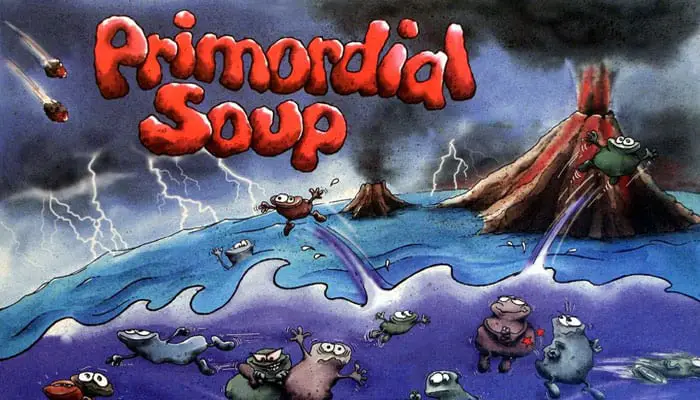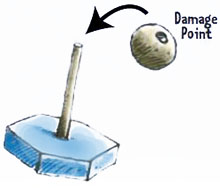
Components

- 1 Game Board
- 28 Amoebas
- 37 Biological Points
- 25 Damage Point (DP) beads.
- 220 Foodstuff cubes
- 33 Gene Cards
- 11 Environment Cards
- 2 Dice
- 4 Reference Booklets
- Rulebook
Object of the Game
Each player controls a tribe of amoebas, at a time in the earth's history when there were no higher forms of life. At the start of the game the amoebas can feed, multiply and move in an uncoordinated fashion.
By buying Genes, players can extend the capabilities of their amoebas, changing the way that the game's rules operate on them and so influencing the development of their tribe.
Obviously it isn't always easy, but the more living amoebas you have, and the greater their capabilities, the greater the advance of evolution, which is the way to victory in this game.
Setup
The Game Board should be laid out open in the center of the table. Each player chooses a color and takes all the amoebas of that color, 1 reference booklet and 4 *Biological Points (BP) for himself. The big BPs count as 5.

Place two *Foodstuff cubes of each color in play, onto every space on the board. The remaining Foodstuff cubes should be placed some- where handy. Foodstuff cubes and amoebas in colors that have not been chosen should be put away as they are not used in the game.
If there are only 3 players, only the Gene Cards With A "3" On Their bottom corner are used.
Shuffle the Environment Cards, and place one, face up, on the *Compass in the center of the Board. The rest of the Environment Cards are put face down.

Players then choose the order of play for the first round. Each player rolls two dice; the player who rolls highest, places his Score marker on any one of the four spaces marked 1 - 4 on the board. (With three players, one of the spaces marked 1 - 3).
Then the player who had the second highest roll chooses a space for himself and so on. Only one Score marker may be on each space at a time.


In Ascending Order (i.e. starting with the player whose marker is in the "1" space), players place one of their , amoebas onto an empty space on the board, and also give these amoebas one *Damage Point (DP).
If there are only three players, these amoebas don't receive a DP. Then in *Descending Order, players place a second amoeba onto an empty space on the board but those amoebas do not receive a DP.
Players may use any of their amoebas, not necessarily the one marked #1. At the end of this setup, no space may contain more than one amoeba.
Game Play
The game is divided into Rounds. Each round consists of 6 phases, which are carried out in the order given.
Phase 1: Movement And Feeding
Play in Ascending Order. The player whose turn it is must deal with each of his amoebas on the board in Numerical Order (1-7).
Each amoeba has one of two options:
-
The amoeba may allow itself to Drift
The amoeba drifts one space in the direction shown on the Environment Card (indicated in red) face up on the Compass. If there is an obstacle (edge of board, Compass), the amoeba stays put. Other amoebas are not obstacles and more than one amoeba may share the same space.
-
The amoeba may move, using its own strength.

If the amoeba hasn't yet acquired any extra genes, this will take the form of uncoordinated movement. The player pays 1 Biological Point (BP) and rolls a die.
The amoeba then moves one space in the direction shown by that die roll; (l=West, 2=North, etc). A roll of 5 means that the amoeba remains in place; a 6 gives the player a free choice of direction.
If the movement would involve hitting an obstacle, the move is not carried out.
Each amoeba must either drift or move. Staying put is only possible with the appropriate die roll (a 5), if there is an obstacle, or if there is no drift (the middle of the Compass pictured on the current Environment Card is shaded red).
Feeding
Once the amoeba has moved or drifted, it attempts to feed. An amoeba eats three Foodstuff cubes per turn, but never one of its own color. In a four player game it eats one cube of each of the other three colors.
In a three player game, it eats one Foodstuff cube of one color and two of another color - the player decides which color is eaten once and which twice. If an amoeba finds enough food, the food that it has eaten is replaced by two cubes of the amoeba's own color.
In the course of the game this may lead to a shortage of Food on that space. (The cubes that are lacking are not replaced with another color).

An amoeba that fails to find enough food starves. It doesn't eat or excrete and receives one Damage Point.

Once an amoeba has moved and eaten (or failed to), the next amoeba takes its turn. Once a player has dealt with all his amoebas on the board, the next player in Ascending Order takes his turn.
Phase 2: Environment And Gene Defects

The old Environment Card on the Compass is removed, and a new one put on the Compass.
Gene Defects do not occur during the first round. In subsequent rounds, each player, in Descending Order, adds all the mutation Points on his Gene Cards together. If the total is greater than the ozone Layer Thickness, as shown on the current Environment Card, then he must balance the difference.
He can do this by giving up Genes and/or by paying Biological Points (BP).
Genes which have been given up count as the number of Mutation Points on them; each BP counts as 1. If the only way to balance the difference is by giving up more points on Genes than is necessary, the player loses the extra points.

Genes returned to the pool can be bought again.
Phase 3: New Genes
In Descending Order, each player can use BPs to buy new Genes. Each player in turn has one chance to buy the card or cards they want and can afford.
No player may possess a duplicate Gene. The Genes are described in detail in the reference booklets. The rules on the Gene Cards override the standard rules. A new Gene immediately applies for all amoebas of a player.
Phase 4: Cell Division
Play in Descending Order. A player first gets 10 BPs. Using these, plus any that they may have saved from earlier rounds, they may cause their amoebas to divide. At a price of 6 BPs per amoeba, one or more new amoebas with no Damage Points may be placed on the board.
New amoebas must be placed in a space that contains no amoeba of the same color but that borders (horizontally or vertically but not diagonally) a space which already contains an amoeba of the same color. This amoeba may be one that has just been placed on the board.

If a player has no amoebas left on the board, he may place one amoeba free in a space of his choice. If a player only has one amoeba on the board, he may place a second anywhere on the board, but must still pay the normal cost.
Phase 5: Deaths

Amoebas that have 2 or more Damage Points die a natural *Death. If an amoeba dies, it is removed from the board, and replaced by two Foodstuff cubes of each of the four (or three) colors in play.
Amoebas that have died may be used again by the player later in the game.
Phase 6: Scoring
In Descending Order, the players' Score Markers are moved. The amount advanced is dependent on the number of live amoebas that the player has on the board and on how many Genes the player has.
Advance Table
Important: Advanced Genes (persistence, movement II, aggression, armor) count as two cards on the advance table. The Gene ray protection does not count towards advancing.
Spaces on the scoring Ladder that are already occupied are "leapfrogged", so that there is only ever one marker per space on the ladder.
Example: 7 spaces

End of the Game
If, after all markers have advanced, there are no markers in the dark finish zone of the scoring ladder, the game enters another round, starting again with phase 1.
If, however, one or more markers have reached the dark finish zone at the end of the scoring ladder, the game ends at this point. Alternatively, the game ends after the Scoring phase in the round in which the last Environment Card is turned over.
The player whose marker is furthest along the Scoring Ladder wins the game.
You can shorten the game by declaring an earlier Finish Zone.

Continue Reading

